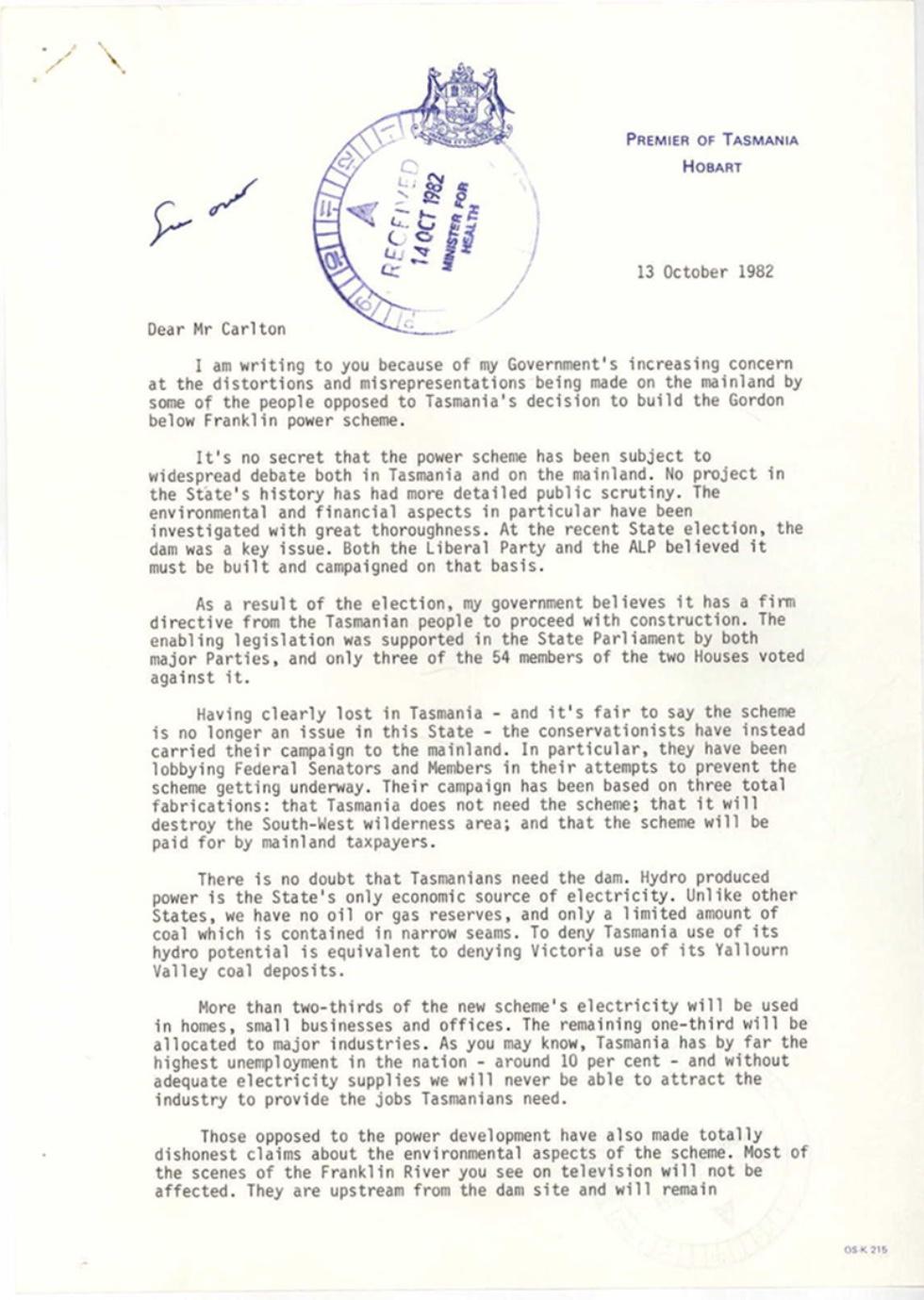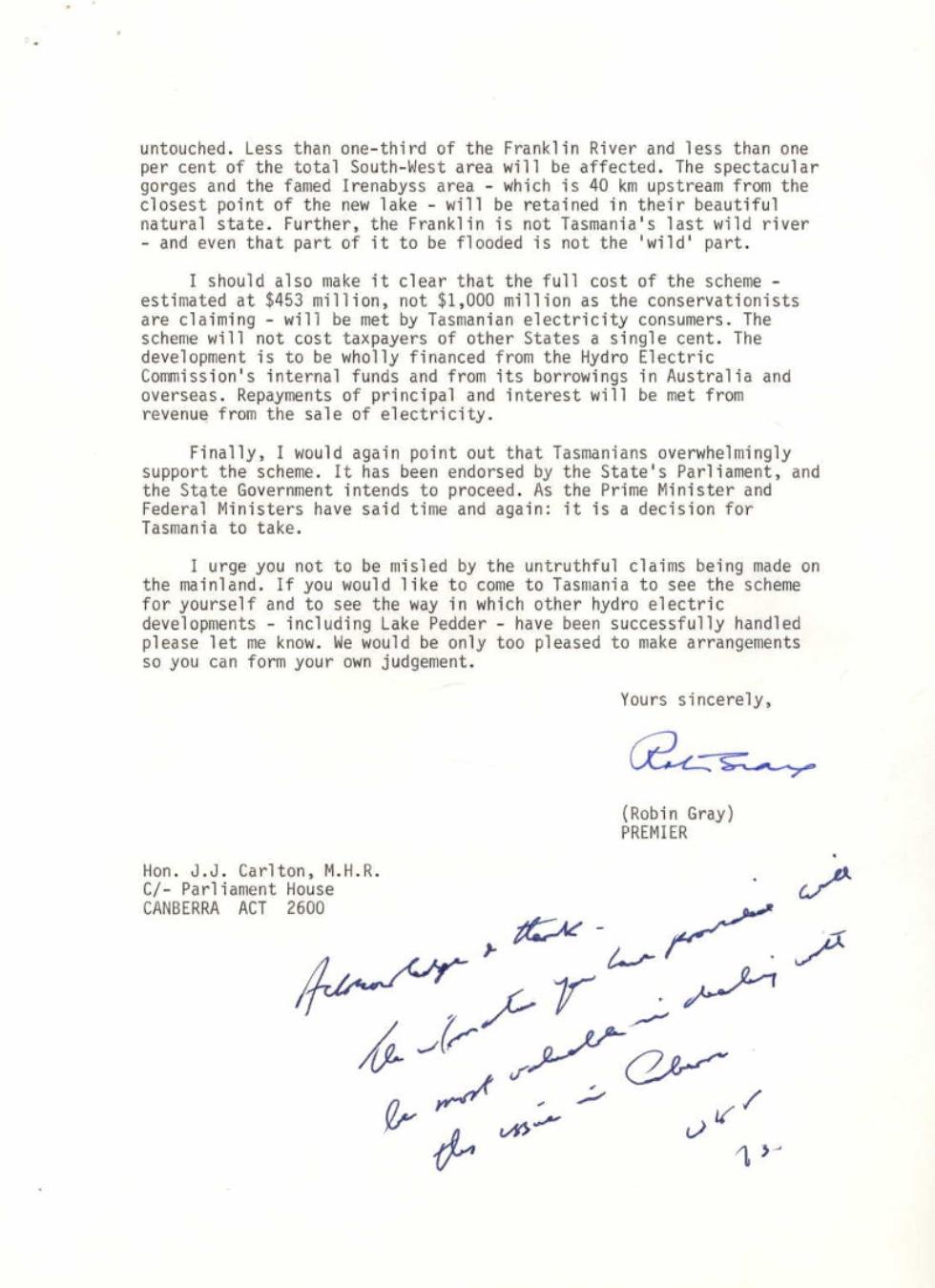

Aboriginal and Torres Strait Islander people should be aware that the National Archives' website and collection contain the names, images and voices of people who have died.
Some records include terms and views that are not appropriate today. They reflect the period in which they were created and are not the views of the National Archives.



[page 1]
[top left, blue ink, handwritten, illegible]
[Letterhead: blue ink Australian coat of arms]
[Stamp, blue ink circle, half circle faded, other half are numbers nine, ten, eleven, twelve, one, arrow points to eleven. Stamp is overlapping Coat of Arms. In the centre of stamp, capitalised, reads 'RECEIVED 14 OCT 1982 MINISTER FOR HEALTH']
[top right, blue ink] Premier of Tasmania
Hobart
[Black ink, typed] 13 October 1982
Dear Mr Carlton
I am writing to you because of my Government's increasing concern at the distortions and misrepresentations being made on the mainland by some of the people opposed to Tasmania's decision to build the Gordon below Franklin power scheme.
It's no secret that the power scheme has been subject to widespread debate both in Tasmania and on the mainland. No project in the State's history has had more detailed public scrutiny. The environmental and financial aspects in particular have been investigated with great thoroughness. At the recent State election, the dam was a key issue. Both the Liberal Party and the ALP believed it must be built and campaigned on that basis.
As a result of the election, my government believes it has a firm directive from the Tasmanian people to proceed with construction. The enabling legislation was supported in the State Parliament by both major Parties, and only three of the 54 members of the two Houses voted against it.
Having clearly lost in Tasmania – and it's fair to say the scheme is no longer an issue in this state – the conservationists have instead carried their campaign to the mainland. In particular, they have been lobbying Federal Senators and Members in their attempts to prevent the scheme getting underway. Their campaign has been based on three total fabrications: that Tasmania does not need the scheme; that it will destroy the South-West wilderness area; and that the scheme will be paid for by mainland taxpayers.
There is no doubt that Tasmanians need the dam. Hydro produced power is the State's only economic source of electricity. Unlike other States, we have no oil or gas reserves, and only a limited amount of coal which is contained in narrow seams. To deny Tasmania use of its hydro potential is equivalent to denying Victoria use of its Yallourn Valley coal deposits.
More than two-thirds of the new scheme's electricity will be used in homes, small businesses and offices. The remaining one-third will be allocated to major industries. As you may know, Tasmania has by far the highest unemployment in the nation – around 10 per cent – and without adequate electricity supplies we will never be able to attract the industry to provide the jobs Tasmanians need.
Those opposed to the power development have also made totally dishonest claims about the environmental aspects of the scheme. Most of the scenes of the Franklin River you see on television will not be affected. They are upstream from the dam site and will remain
[bottom right corner, tiny print] 05 K 215
[end of page 1]
[page 2]
[continued] untouched. Less than one-third of the Franklin River and less than one per cent of the total South-West area will be affected. The spectacular gorges and the famed Irenabyss area – which is 40 km upstream from the closest point of the new lake – will be retained in their beautiful natural state. Further, the Franklin is not Tasmania's last wild river – and even that part of it to be flooded is not the 'wild' part.
I should also make it clear that the full cost of the scheme – estimated at $453 million, not $1,000 million as the conservationists are claiming – will be met by Tasmanian electricity consumers. The scheme will not cost taxpayers of other States a single cent. The development is to be wholly financed from the Hydro Electric Commission's internal funds and from its borrowings in Australia and overseas. Repayments of principal and interest will be met from revenue from the sale of electricity.
Finally, I would again point out that Tasmanians overwhelmingly support the scheme. It has been endorsed by the State's Parliament, and the State Government intends to proceed. As the Prime Minister and Federal Ministers have said time and again: it is a decision for Tasmania to take.
I urge you not to be misled by the untruthful claims being made on the mainland. If you would like to come to Tasmania to see the scheme for yourself and to see the way in which other hydro electric developments – including Lake Pedder – have been successfully handled please let me know. We would be only too pleased to make arrangements so you can form your own judgement.
Yours sincerely,
[signature, blue ink] Rob Gray
[typed] (Robin Gray)
PREMIER
Hon. J.J. Carlton, M. H. R.
C/- Parliament House
CANBERRA ACT 2600
[Darker blue ink, handwritten] Acknowledge and thank. The information you have provided will be most valuable in dealing with this issue in Canberra
w r r
73.
This is a letter from the Premier of Tasmania, Robin Gray, to the federal Minister for Health, James Joseph (J.J.) Carlton. A premier is the leader of a state government, and they are responsible for being the spokesperson for their government.
Robin Gray was a member of the Liberal Party and served as Premier of Tasmania from 1982 to 1989. His time as premier was marked by struggles with high unemployment in Tasmania, the challenge of attracting new industry to the region, and environmental protests against his government's hydro-electric developments.
Throughout his premiership, Gray advocated for the rights of the states to make their own decisions – this is a key theme that comes through this 1982 letter to J.J. Carlton. When Gray wrote this letter, environmental protestors were lobbying for the Australian Government to intervene in Tasmania to stop the construction of the Gordon-below-Franklin hydro-electric dam.
In this letter, Gray details the following reasons why the dam should be built:
The Tasmanian Government was motivated to build dams to meet the state's energy needs and to create jobs. The hydro-electric sector was the largest state employer in Tasmania at the time, and the building of the Franklin-below-Gordon dam was seen by many Tasmanians as necessary to increase employment opportunities. At 12.5 percent, Tasmania had the highest unemployment rate in Australia at the time.
Premier Gray also draws attention to what he believes are "the distortions and misrepresentations being made on the mainland by some of the people opposed to Tasmania's decision" to build the dam. Premier Gray included a labelled map with his letter, which shows the location of key environmental features as well as the proposed location of the dam.
After writing this letter Premier Robin Gray continued to advocate strongly for Tasmania's right to dam the Franklin River, going so far as to threaten to have federal police arrested if they intervened on the land around the dam.
In 1983 the Australian Government did pass legislation that would make the building of the dam illegal. The Tasmanian Government challenged this decision in the High Court of Australia, where it was found that the Australian Government had acted within their Constitutional power. Premier Gray had to accept the decision of the High Court, and so ultimately lost the battle to have the Franklin-below-Gordon dam built.
The Minister for Home Affairs and the Environment in October 1982 was Tom McVeigh. Why might Premier Gray write to J.J. Carlton instead?
How persuasive did you find Premier Gray’s reasons for building the dam? Consider what some counterarguments would be, from the perspective of the Australian Government.
Learn how to interpret primary sources, use our collection and more.
